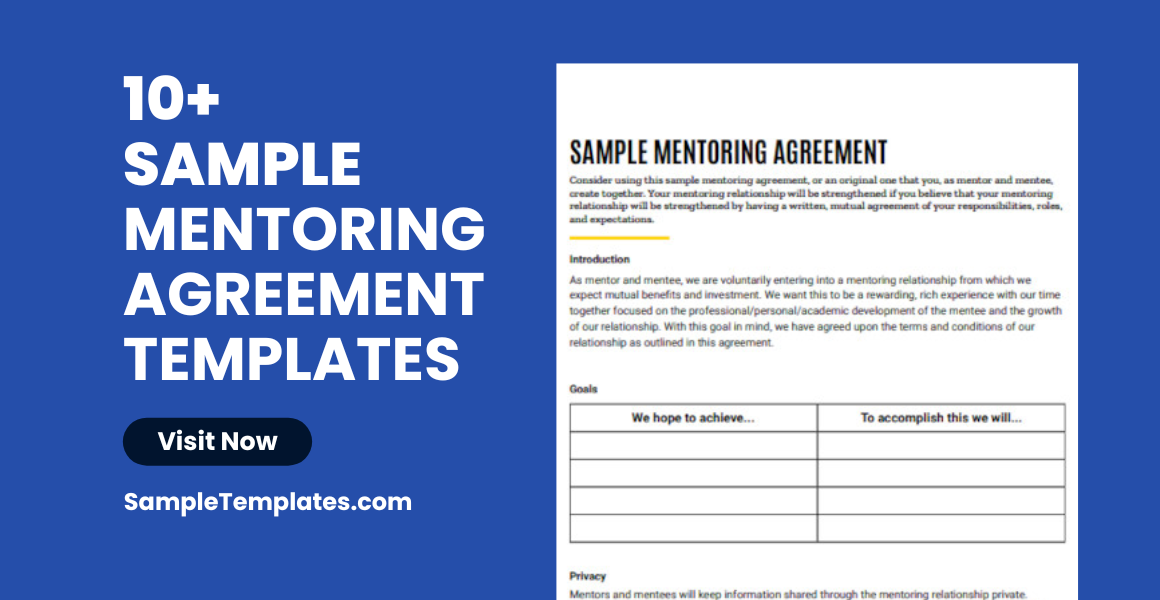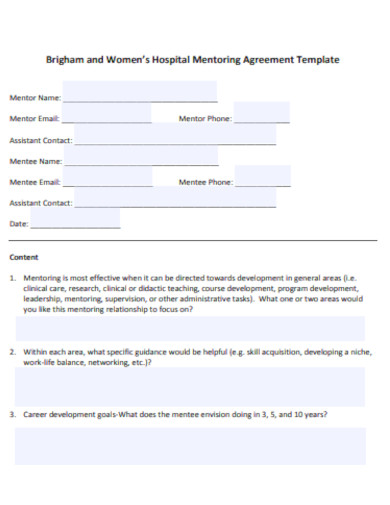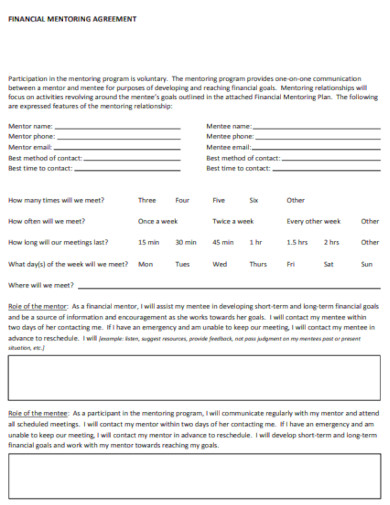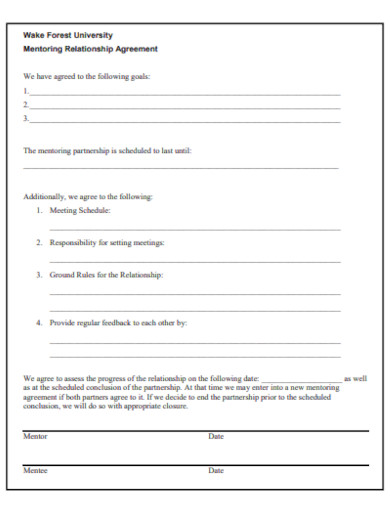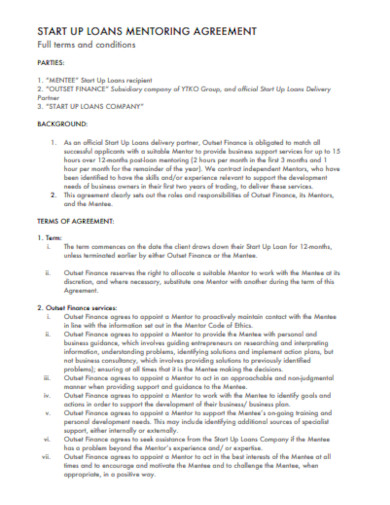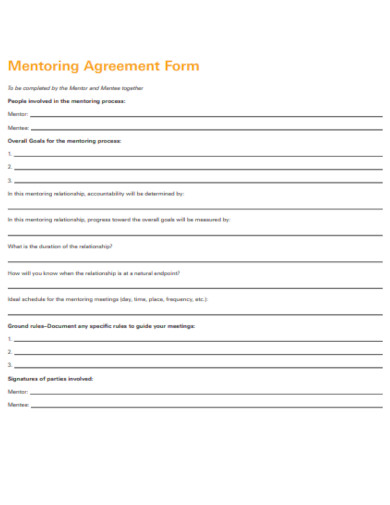10+ Mentoring Agreement Samples
1. Sample Teacher Mentoring Agreement Template

2. Sample Mortgage Broker Mentoring Agreement Template
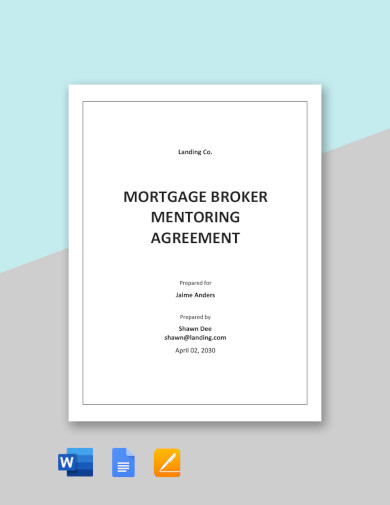
3. Sample Mentoring Partnership Agreement Template
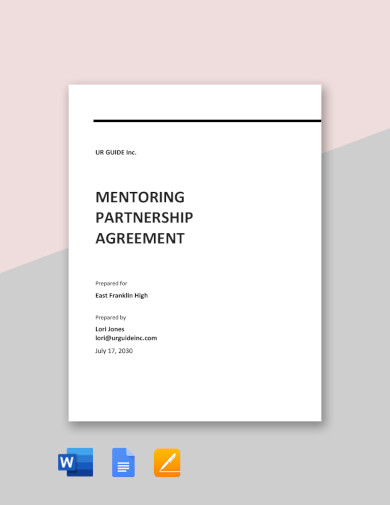
4. Sample Mentoring Confidentiality Agreement Template
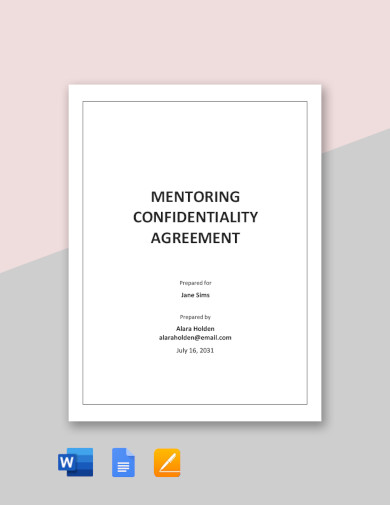
5. Sample Peer Mentoring Agreement Template
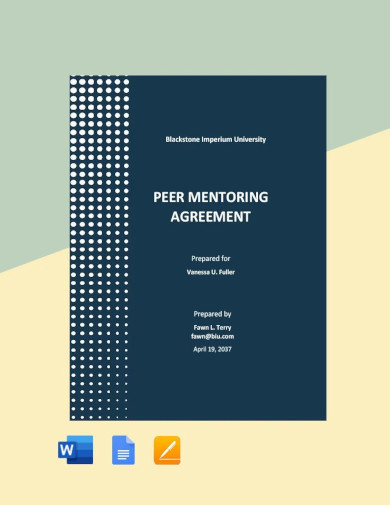
What is a Mentoring Agreement?
A mentoring agreement is a formal document that outlines the expectations, goals, responsibilities, and the overall structure of a mentoring relationship. It serves as a mutual contract between a mentor and a mentee to ensure clarity and commitment from both parties. This agreement format is pivotal in setting the tone for a constructive and beneficial partnership.
Understanding the Purpose of a Mentoring Agreement
The primary purpose of a mentoring agreement is to establish a clear understanding of what each party wants to gain from the relationship. It helps in setting boundaries, defining the length of the mentoring period, and the frequency of meetings. It also provides a roadmap for the mentorship, detailing the specific areas of development for the mentee.
Key Components of a Mentoring Agreement
A comprehensive mentoring agreement typically includes the following elements:
- Introduction of Participants: A sample brief introduction of the mentor and mentee, including their backgrounds and areas of expertise.
- Objectives and Goals: Specific, measurable, achievable, relevant, and time-bound (SMART) goals that the mentee aims to accomplish with the mentor’s guidance.
- Mentoring Schedule: A sample schedule that outlines the frequency, duration, and format of mentoring sessions, whether they be in-person, over the phone, or through video conferencing.
- Confidentiality Clause: An agreement on how the information shared during the mentoring sessions will be treated, emphasizing privacy and trust.
- Duration of the Agreement: The time frame of the mentoring relationship, with provisions for extension or early termination if necessary.
- Roles and Responsibilities: A detailed description of what is expected from the mentor and the mentee, including preparation for sessions and follow-up actions.
- Resources and Tools: Any materials, tools, or resources that will be used throughout the mentoring process.
- Feedback and Evaluation: Methods and frequency of providing a sample feedback, as well as a plan for evaluating the progress towards the mentee’s goals.
- Signatures: A section for both the mentor and the mentee to sign the agreement, indicating their commitment to the terms outlined.
Benefits of Having a Mentoring Agreement
The benefits of a mentoring agreement are manifold:
- It encourages mutual respect and understanding.
- It helps avoid misunderstandings by providing a written record of what has been agreed upon.
- It sets a professional tone and demonstrates a serious commitment to the mentoring relationship.
- It provides a sample roadmap for the mentor and mentee, helping them stay focused and on track.
The objectives of a mentoring agreement typically include:
- Clarifying Roles: Defining what mentors and mentees should expect from each other.
- Setting Goals: Outlining specific, achievable sample objectives for the mentee’s personal and professional development.
- Establishing Boundaries: Determining the scope and limits of the mentoring relationship.
- Scheduling: Agreeing on the frequency, duration, and format of mentoring sessions.
- Ensuring Commitment: Formalizing the mentor’s and mentee’s dedication to the mentoring process.
- Maintaining Confidentiality: Protecting the privacy of the discussions and any sensitive information shared.
- Providing Structure: Creating a roadmap for the mentoring relationship to follow.
- Facilitating Evaluation: Setting up milestones and feedback mechanisms to assess progress.
- Promoting Professionalism: Encouraging a professional approach to the mentoring relationship.
- Allowing Flexibility: Permitting the agreement to be adjusted as the mentoring relationship develops.
In a mentoring agreement, you should include the following elements:
1. Introduction: Names and roles of the mentor and mentee, along with the date the agreement is made.
2. Purpose Statement: A brief description of the mentoring program’s objectives and what the agreement aims to accomplish.
3. Goals and Objectives: Specific goals that the mentee aims to achieve with timelines, if possible.
4. Mentoring Schedule: Details on how often and when the mentor and mentee will meet, including the length and format of meetings.
5. Roles and Responsibilities:
a) Mentor’s Responsibilities: Guidance provided, availability, and support expectations.
b) Mentee’s Responsibilities: Preparation for meetings, openness to feedback, and commitment to work on agreed-upon goals.
6. Confidentiality: Agreement on how sensitive information will be treated during and after the mentoring relationship.
7. Communication: Preferred methods and frequency of communication between scheduled meetings.
8.Progress Review: How and when the mentoring progress will be evaluated.
9. Adjustment Clause: Provision for making changes to the agreement as needed.
10. Termination: Conditions under which the mentoring agreement can be concluded.
11. Signatures: Spaces for both mentor and mentee to sign and date the agreement, confirming their commitment to its terms. You can also see more templates like Student Agreement Samples.
6. Sample Mentoring Agreement Template
7. Sample Hospital Mentoring Agreement Template
8. Sample Financial Mentoring Agreement Template
9. Sample Mentoring Relationship Agreement Template
10. Sample Start Up Loans Mentoring Agreement Template
11. Sample Mentoring Agreement Form Template
How to Write a Mentoring Agreement?
Writing a mentoring agreement involves clear communication between the mentor and the mentee to establish a structured and effective relationship. You can also see more templates like Service Agreement Contracts. Here’s a step-by-step guide to help you write a mentoring agreement:
Step 1: Establish the Basics Begin by identifying the mentor and mentee with full names and titles, if applicable. Set the date of the agreement and the intended duration of the mentoring relationship.
Step 2: Define the Purpose Clearly state the purpose of the mentoring relationship. This could be for career development, skill enhancement, or personal growth. Ensure that the purpose aligns with the mentee’s professional objectives.
Step 3: Outline Goals and Objectives List the specific goals and objectives that the mentee wishes to achieve. These should be SMART: Specific, Measurable, Achievable, Relevant, and Time-bound.
Step 4: Schedule and Format Decide on the logistics of the mentoring sessions. Include the frequency of meetings, their duration, location, and whether they will be in-person or virtual.
Step 5: Roles and Responsibilities Detail what is expected from both the mentor and the mentee. For the mentor, this might include providing guidance, feedback, and resources. For the mentee, this could involve preparation for meetings, active participation, and application of learned skills.
Step 6: Confidentiality Clause Include a clause that ensures both parties agree to keep the content of their discussions private, fostering an environment of trust.
Step 7: Progress Review and Feedback Describe how and when progress will be reviewed. This could be through regular check-ins or at the end of the mentoring period. Also, outline how feedback will be given and received.
Step 8: Termination Conditions Explain the conditions under which the mentoring agreement can be terminated, such as failure to meet the agreement terms or at the request of either party with prior notice.
Step 9: Signatures Conclude the agreement with a section for both parties to sign and date, indicating their commitment to the terms of the mentoring relationship.
Step 10: Review and Revise Before finalizing, both parties should review the agreement to ensure it meets their needs and expectations. Be open to revising the document until both the mentor and the mentee are satisfied.
Finalizing the Agreement Once both parties agree on the content, sign the document to formalize the mentoring agreement. Keep a copy for each party’s records.
What Happens if Either the Mentor or Mentee Fails to Meet their Obligations under the Agreement?
If either the mentor or mentee fails to meet their obligations under the agreement, it may lead to a discussion to address the issue, a revision of the agreement, or ultimately, the termination of the mentoring relationship.
When should a Mentoring Agreement Come to an End?
A mentoring agreement should come to an end when the set goals are achieved, the specified time period expires, either party wishes to terminate the relationship, or when it no longer serves the intended purpose of professional growth and development.
Why have a Mentoring Agreement?
Having a mentoring agreement is important because it sets clear expectations, defines goals, and establishes the framework for a structured and effective mentoring relationship. It ensures both mentor and mentee are aligned and committed to the process, which can greatly enhance the outcome of the mentoring experience.
Related Posts
FREE 10+ Partner Agreement Samples In MS Word | Google Docs | Apple Pages | PDF
FREE 10+ Individual Agreement Samples In MS Word | Google Docs | Apple Pages | PDF
FREE 10+ Strategic Agreement Samples In MS Word | Google Docs | Apple Pages | PDF
FREE 10+ Equity Agreement Samples In MS Word | Google Docs | Apple Pages | PDF
FREE 10+ Producer Agreement Samples in MS Word | Apple Pages | PDF
FREE 10+ Grant Agreement Samples In MS Word | Apple Pages | PDF
FREE 8+ Meeting Agreement Samples in MS Word | Google Docs | Apple Pages | PDF
FREE 10+ Community Agreement Samples In MS Word | Google Docs | PDF
FREE 8+ Real Estate Option Agreement Samples in MS Word | PDF
FREE 10+ Call Option Agreement Samples In MS Word | PDF
FREE 10+ Advertising Agreement Samples In MS Word | Google Docs | Apple Pages | PDF
FREE 10+ Car Agreement Samples In MS Word | Google Docs | Apple Pages | PDF
FREE 10+ Horse Agreement Samples In MS Word | Apple Pages | PDF
FREE 10+ Option Agreement Samples In MS Word | Google Docs | Apple Pages | PDF
FREE 9+ Project Management Agreement Samples in DOC | PDF
